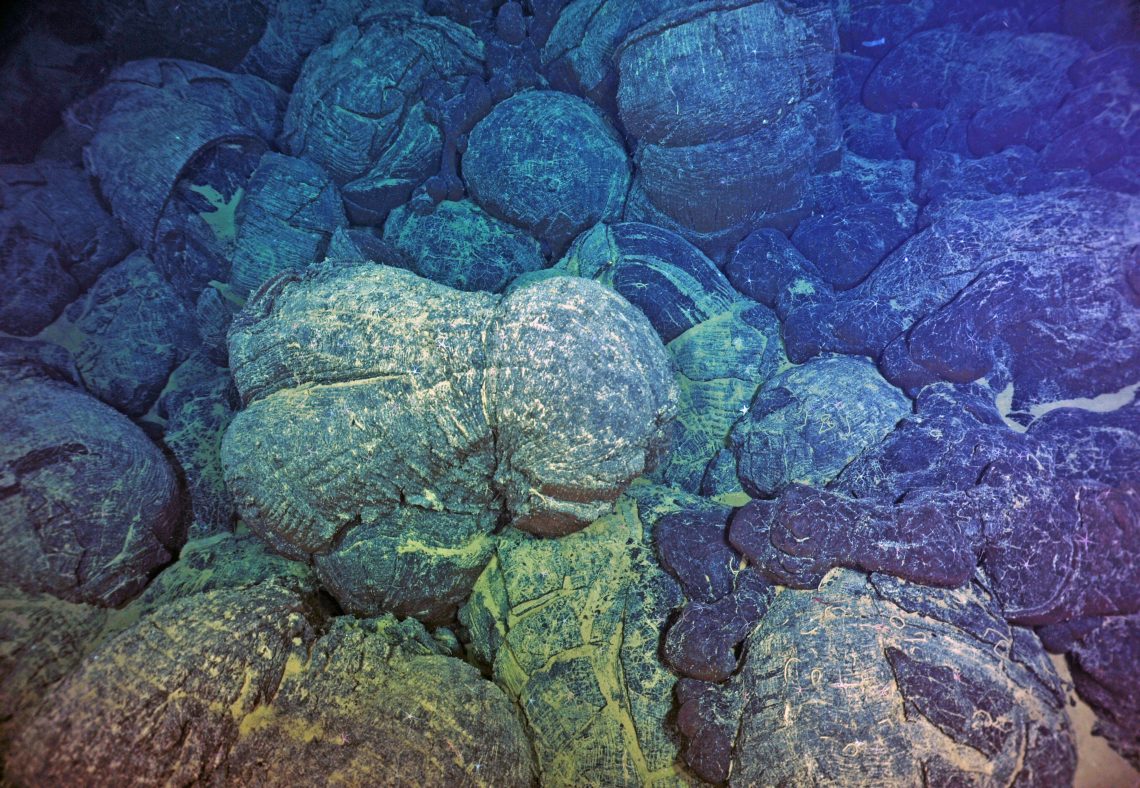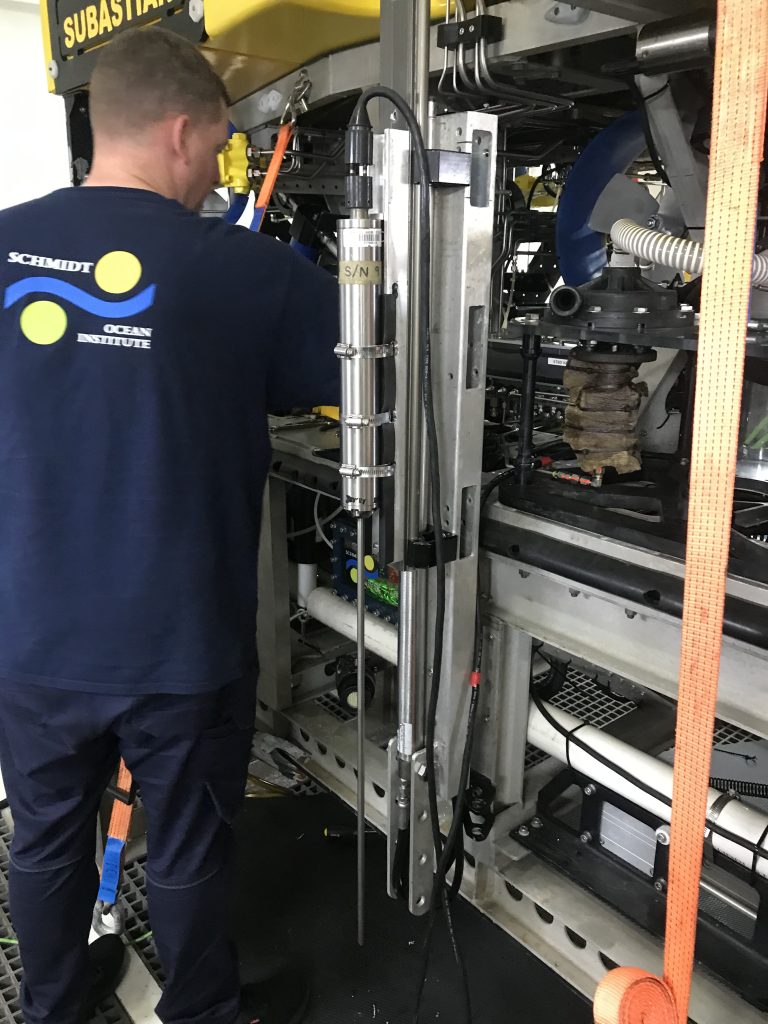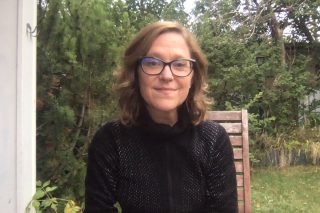Traducción al español a continuación
In addition to the biologists studying octopus, the science party on the Falkor (too) includes a geophysicist (me) and a hydrogeologist (Dr. Rachel Lauer). Our role is to study what is happening beneath the seafloor to understand better the “plumbing” that moves fluids into and out of the ocean crust, which supports favorable conditions for brooding deep-sea octopuses. To understand how we’re doing this, we start by considering what the seafloor is made of.
When the new crust is formed at mid-ocean ridges, lava is extruded and rapidly cools, forming pillow-shaped rocks like those shown here [Picture 1]. Together, these “pillows” make up the upper layer of the oceanic crust, and the spaces between the pillows help make the crust very permeable. As the crust ages, it gets covered by sediments that form an insulating blanket that keeps heat from escaping and creates a seal, preventing water from circulating into and out of the crust. However, seamounts and smaller rock exposures at the sea floor provide access points for seawater to flow into and out of the crust. These access points draw cold, dense water into the crust in some places where it is warmed by the Earth’s heat and circulates until it finds an exit point out of the crust (another seamount). [Picture 2] This process is called hydrothermal circulation and leads to different temperatures that vary depending on the plumbing of the system. It’s this plumbing, and locations where water is going into and coming out of the crust, that we think helps to provide suitable conditions for the octopods that we’re here to study.

So, what are we doing to understand this system better? We’re measuring temperatures in the seafloor sediments using a heat-flow probe that we manipulate using SuBastian [Picture 3]. Seawater near the seafloor is relatively cold (~2 Celsius), which cools the crust down when it flows into the ocean crust. The seawater gets warmed up as it moves through the crust and gets discharged at the seafloor warmer than it was originally. A previous study in this area showed that water can travel a long way between seamounts but may also form small convection cells, possibly circulating within the same seamount. We can understand the patterns of these flow paths by measuring temperatures; where the seafloor is colder than it should be, fluid is moving into the crust, and where the seafloor is warmer than it should be, fluid is moving out of the crust.


Seamounts are ubiquitous on the seafloor; a recent article published in Earth and Space Science (Gevorgian et al., 2023) mapped the location of tens of thousands of newly identified seamounts. While we’ve observed brooding deep-sea octopods in other places, such as the Davidson Seamount-the setting for a “Blue Planet Live” episode from the BBC describing brooding octopods, the Dorado outcrop is one of the few places in the world where we have enough data to understand what might be happening below the seafloor. We think that the conditions at Dorado are similar to those at many of the tens of thousands of unexplored seamounts around the world, so what we learn here can provide valuable insight into what may be a global phenomenon.
Flujo de fluidos a través de la corteza
Además de las biólogas que estudian a los pulpos, el equipo científico a bordo del Falkor (too) también incluye a un geofísico (mi persona) y a una hidrogeóloga (la Dra. Rachel Lauer). Nuestro papel es estudiar lo que está ocurriendo debajo del lecho marino para comprender mejor cómo se mueven los fluidos dentro y fuera de la corteza oceánica, que podrían estar generando condiciones favorables para la crianza de pulpos de aguas profundas.
Para entender lo que estamos haciendo es necesario comprender primero de qué está hecho el lecho marino. Cuando se forma nueva corteza en las dorsales oceánicas, se extruye lava que se enfría rápidamente, formando rocas con forma de almohadilla, como las que se muestran aquí [Imagen 1]. Juntas, estas “almohadillas” conforman la capa superior de la corteza oceánica y los espacios entre ellas ayudan a que la corteza sea muy permeable. A medida que la corteza envejece, se va cubriendo de sedimentos que forman una capa aislante que impide que el calor escape y que crea un sello que evita que el agua circule dentro y fuera de la corteza. Sin embargo, los montes submarinos y otras exposiciones rocosas de menor tamaño que los montes submarinos (pinnáculos) proporcionan puntos de acceso para que el agua de mar fluya dentro y fuera de la corteza. Estos puntos de acceso succionan agua fría y densa hacia la corteza en algunos lugares, donde se calienta por el calor de la Tierra y circula hasta encontrar un punto de salida fuera de la corteza (otro monte submarino, pinnáculo o exposición de roca) [Imagen 2]. Este proceso se conoce como circulación hidrotermal y genera diferentes temperaturas que varían según la estructura del sistema. Es este sistema dentro de la corteza por donde se mueve el agua y los lugares donde el agua entra y sale de ella, lo que creemos que proporciona condiciones adecuadas para los pulpos que estamos estudiando en la expedición.
Entonces, ¿qué estamos haciendo para comprender mejor este sistema? Estamos midiendo las temperaturas en los sedimentos del lecho marino utilizando una sonda de flujo de calor, que manipulamos con SuBastian [Imagen 3]. El agua de mar cerca del lecho marino es relativamente fría (~2 oC), por lo que cuando fluye hacia la corteza oceánica enfría la corteza. El agua de mar se calienta a medida que va atravesando la corteza y se descarga en el lecho marino más caliente de lo que era originalmente. Un estudio previo en esta área mostró que el agua puede recorrer largas distancias entre los montes submarinos o pinnáculos de roca expuesta, pero que también puede formar flujos a menor distancia, posiblemente circulando dentro del mismo monte submarino o pinnáculo. Podemos comprender los patrones de flujo de agua mediante la medición de temperaturas: donde el lecho marino está más frío de lo esperado, el fluido de agua está ingresando a la corteza, y donde el lecho marino está más cálido de lo esperado, el fluido está saliendo de la corteza.
Los montes submarinos y los pinnáculos de roca expuesta se encuentran alrededor del globo en el lecho marino; un artículo reciente publicado en Earth and Space Science (Gevorgian et al., 2023) mapeó la ubicación de decenas de miles de montes submarinos recién identificados. Si bien hemos observado pulpos de aguas profundas en otros lugares, como en el monte submarino Davidson, que fue escenario de un episodio de “Blue Planet Live” de la BBC que describe la crianza de los pulpos, el pinnáculo de roca Dorado que estamos estudiando es uno de los pocos lugares en el mundo donde tenemos suficientes datos para comprender lo que podría estar sucediendo debajo del lecho marino. Creemos que las condiciones en Dorado son similares a las de muchos de los decenas de miles de montes submarinos y pinnáculos aún inexplorados en todo el mundo, por lo que lo que aprendamos aquí puede proporcionar una perspectiva valiosa de lo que posiblemente se trate de un fenómeno global.
References
Fisher, A. T. (2005). Marine hydrogeology: Recent accomplishments and future opportunities. Hydrogeology Journal, 13(1), 69–97. https://doi.org/10.1007/s10040-004-0400-y
Gevorgian, J., Sandwell, D. T., Yu, Y., Kim, S.-S., & Wessel, P. (2023). Global distribution and morphology of small seamounts. Earth and Space Science, 10, e2022EA002331


